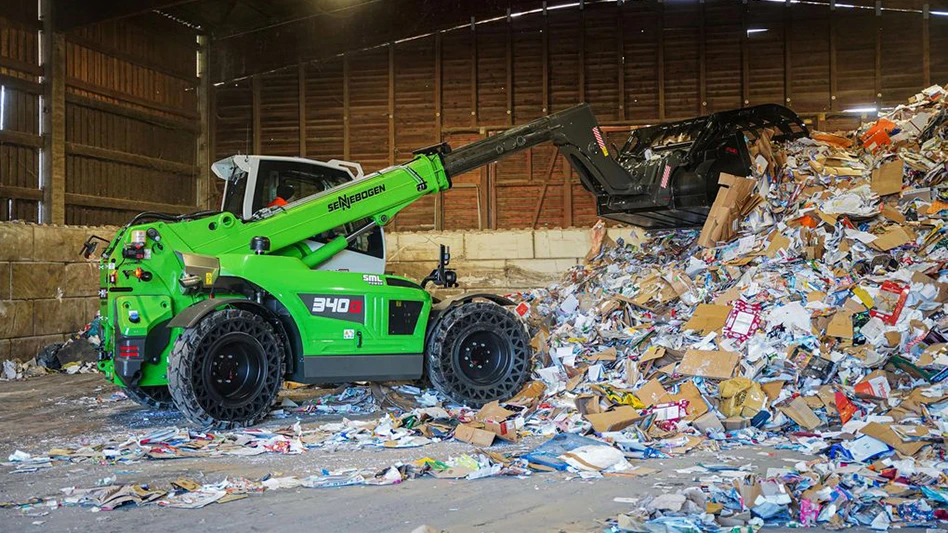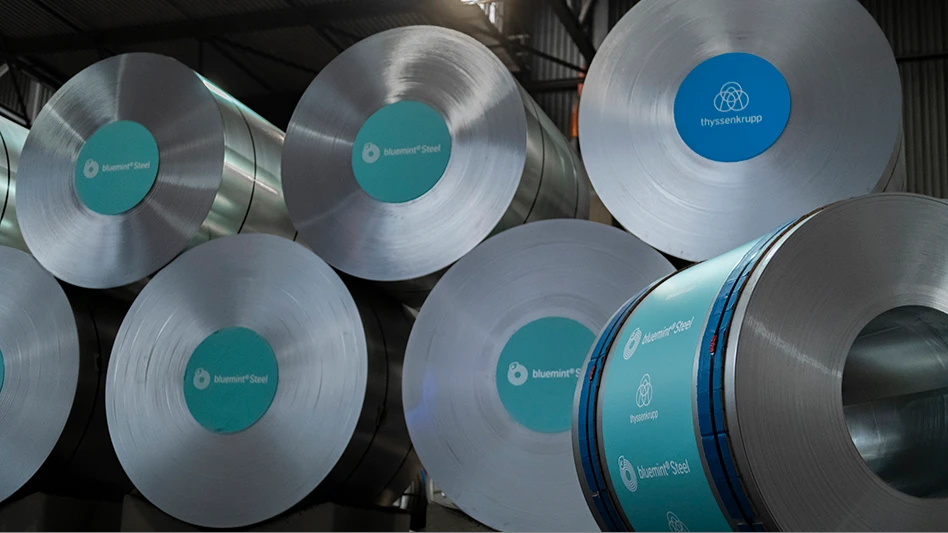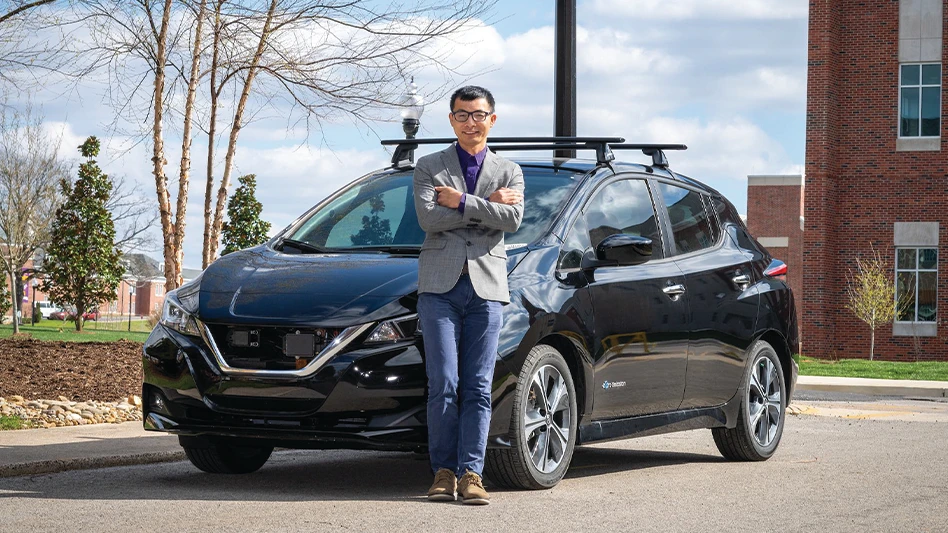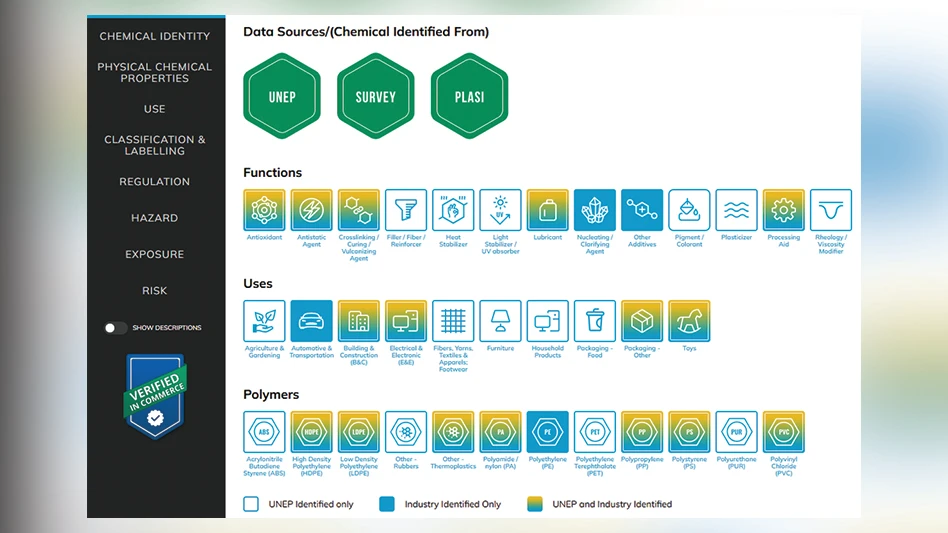 Single-stream material enters the Shoreway Environmental Center’s MRF for processing at this point and is conveyed to the presort station. Single-stream material enters the Shoreway Environmental Center’s MRF for processing at this point and is conveyed to the presort station. |
RethinkWaste celebrated the grand opening of its Shoreway Environmental Center, San Carlos, Calif., Sept. 27, 2011, inviting its board of directors and staff, local and state officials and community leaders to view the newly transformed facility. The Shoreway Environmental Center features a new 70,200-square-foot material recovery facility (MRF), which is home to a dedicated Environmental Education Center. The Shoreway campus also includes a 76,780-square-foot transfer station building, which enables a 30,000-ton-per-year increase in organic materials from local residents and businesses, a new Public Recycling Center, where residents can redeem CRV (California redemption value) bottles and cans and drop off other recyclables, a new scale house and related traffic enhancements.
Kevin McCarthy, executive director of RethinkWaste, says each of these enhancements was part of a master plan of capital improvements designed to enhance diversion capabilities at the integrated facility, improve customer convenience and safety through redesigned traffic flow and provide long-term transfer and processing capacities.
San Carlos-based RethinkWaste (the legal name of which is the South Bayside Waste Management Authority), owns the Shoreway Environmental Center, which receives all of the residential and commercial recyclables, organic materials and solid waste collected in the service area by Recology San Mateo County. South Bay Recycling (SBR) operates the facility for RethinkWaste, which is a joint powers authority made up of 12 member agencies (Atherton, Belmont, Burlingame, East Palo Alto, Foster City, Hillsborough, Menlo Park, Redwood City, San Carlos, San Mateo, the County of San Mateo and the West Bay Sanitary District) in San Mateo County. SBR is a joint venture between the California companies Community Recycling & Resource Recovery Inc. and Potential Industries Inc.
Need for Expansion
McCarthy says the introduction of single-stream recycling services necessitated the expansion of the Shoreway Environmental Center. "With the rollout of new residential and commercial single-stream recycling services planned for Jan. 1, 2011, we needed new processing equipment to handle the expected 30 percent increase in tonnage and to handle a commingled stream of recyclables versus the previous dual-stream [program]," he says.
The pre-existing 48,000-square-foot MRF building, which was originally built in 1968 and retrofitted into a MRF in the early '90s, was inefficient in terms of building layout, McCarthy says. "The new MRF building is 70,000 square feet and is substantially free span, allowing for a more efficient use of floor space."
 Shoreway Environmental Center visitors enter the MRF through the Environmental Education Center (left) and are greeted by RethinkWaste’s mascot (middle) before viewing museum-quality displays (right). Shoreway Environmental Center visitors enter the MRF through the Environmental Education Center (left) and are greeted by RethinkWaste’s mascot (middle) before viewing museum-quality displays (right). |
LEEding through Example
The Shoreway Environmental Center also features a number of green-building attributes. "As a public agency dedicated to promoting resource conservation and recycling, we wanted to ensure that our facility reflected our core sustainability goals and values," McCarthy says. "We have incorporated dozens of LEED (Leadership in Energy and Environmental Design) and sustainable design features as part of the entire facility master plan," he adds.
|
EDUCATIONAL INITIATIVE According to RethinkWaste, its new Shoreway Environmental Center in San Carlos, Calif., is "a national model for sustainable building practices and innovative recycling and material handling operations" and includes an Environmental Education Center that offers tours of the MRF. This component of the Shoreway Environmental Center is a source of pride and excitement for RethinkWaste and features what the agency describes as "museum-quality exhibits promoting resource conservation and RethinkWaste programs." Kevin McCarthy, executive director of RethinkWaste, says the education center "was created to deliver the unifying message behind all the work we do at RethinkWaste: the message of resource conservation." He adds, "Our education center will teach this message to school children to provide that foundational knowledge of why waste reduction, recycling and composting matter. This education center also fills a critical void in our county, as no such type of education center previously existed." |
Among the notable green-building features are:
- All new buildings feature white (cool) roofs, which cool the surrounding area by reflecting the sun's heat instead of absorbing it.
- A roof-mounted photovoltaic system to be installed this fall will generate renewable energy for the Shoreway Environmental Center.
- Windows, translucent panels and skylights increase natural light and provide a connection with the outdoors.
- Building materials contain post-consumer recycled content.
- The construction waste management plan diverted 95 percent of construction debris from the landfill during construction of the new buildings.
"Many of the features noted above will save us money over the life of the project," McCarthy says. "Our end goal is to also achieve a LEED certification for the facility."
Single-Stream Switch
In a press release announcing the event, RethinkWaste boasts that its new MRF features "the most technologically advanced single-stream processing equipment in the country."
That system, worth roughly $17.6 million, was supplied by Bulk Handling Systems (BHS), Eugene, Ore., and includes a 30-ton-per-hour residential single-stream system and a 20-ton-per-hour commercial system. According to BHS, they incorporate "the latest in patented screening, air and optical technologies to ensure maximum recovery and purity of recyclables at high throughput rates."
McCarthy says the system "has dramatically improved the efficiency of the operations and produced exceptional operational results." The system, which has been in operation since May 2011, has a residue rate of less than 8 percent.
"The equipment selection decision was made as part of, not separate from, the selection of the facility operator," McCarthy says. "Of the maximum available points of 500 for evaluating the facility RFP (request for proposal) responses, 75 points, or 15 percent, was allotted to 'MRF installation and startup proposal (MRF equipment design, installation and startup.)' The key criteria used to evaluate each 'MRF proposal' were the design of the single-stream system, functionality and capabilities of the system (e.g., throughput, effectiveness at sorting materials, labor conservation, etc.), separation efficiency, level of detail, installation plan and company's past experience."
|
IN CASE YOU WERE WONDERING… RethinkWaste has compiled the following information on its Shoreway Environmental Center's material recovery facility (MRF) in San Carlos, Calif.:
|
With the change to single-stream collection of recyclables, additional materials also were accepted for recycling. McCarthy says a wider range of plastic containers, excluding plastic bags, and scrap metal items weighing less than 10 pounds, excluding cable, wire, chain, banding, hand tools and automotive parts, are now welcome.
Funding Fundamentals
The capital improvements to the Shoreway Environmental Center cost $47 million. McCarthy says RethinkWaste analyzed six financing options, including variable rate financing and hybrid options of fixed and variable rate debt, before deciding to use tax-exempt bond proceeds and a member agency loan. "The actual approval of the bond sale occurred on July 23, 2009," he says. "We chose the tax-exempt revenue bonds as the most conservative, risk-averse and proven financing vehicle available."
McCarthy says RethinkWaste used many best practices in its procurement effort, such as including MRF equipment design and installation as part of the scope of services within the facility operations RFP. "In our case, this resulted in seven companies responding to our RFP, with several of the responders submitting multiple equipment design options," he says. "This drove innovation by the potential facility operators and the equipment manufacturers they partnered with."
RethinkWaste set performance standards for the single-stream equipment specifications in the RFP rather than prescribe detailed equipment features and layout. The agency also looked for detailed system test requirements and product quality standards from bidders.
Potential proposers were engaged to review an early draft of the facility operations RFP, McCarthy says. "This was important for early buy-in by the proposers, established trust between the proposers and the JPA (joint powers authority) and provided valuable feedback in the drafting of the final RFP documents."
The selected facility operator, SBR, and its selected equipment manufacturer, BHS, were engaged in the final design of the single-stream equipment that RethinkWaste purchased, he adds.
Finally, McCarthy suggests that public entities include provisions in their facility operations agreements to minimize inbound contamination from franchised loads of recyclables, revenue guarantees and sharing agreements and a structure to reduce plant residue.
This bidding process resulted in a new MRF that has helped to invigorate San Mateo County's recycling program. "We are excited to unveil this new community asset that provides critical green infrastructure to support financial sustainable and environmentally sound programs for our service area of over 450,000 residents," McCarthy says.
The author is managing editor of Recycling Today and can be contacted at dtoto@gie.net.

Explore the November 2011 Issue
Check out more from this issue and find your next story to read.
Latest from Recycling Today
- Harsco brands slag-content asphalt as SteelPhalt
- ArcelorMittal puts French EAF conversions on hold
- Associations ask for effective EPR to drive textile circularity in Europe
- GESA report claims 72 countries recycled EPS in 2023
- Report: Saica exploring recycled paper mill project in Dayton, Ohio
- Hydro’s Alumetal to meet 15 percent of its energy demands through solar
- CSA Group publishes standard defining plastics recycling in Canada
- Second Cyclyx Circularity Center to be located near Fort Worth, Texas





